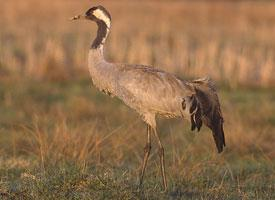
Weights and measures
| Height at the shoulder | 115 cm |
|---|---|
| Weight | 5 kg |
State of endangerment
| Endangered |
Animal description
The Blue Crane, scientifically known as Anthropoides paradisea, stands as a majestic and unique bird, primarily native to the southern regions of Africa. It is distinguished by its striking appearance and elegant stature, making it a captivating subject of admiration and a symbol of grace in the animal kingdom. This species, often referred to as the Paradise Crane or Stanley Crane, is not just a spectacle of beauty but also an emblem of cultural significance, especially in South Africa where it is revered as the national bird.Characteristically, the Blue Crane is a medium-sized crane, with adults reaching a height of about 100 to 120 centimeters (39 to 47 inches) and weighing approximately 4 to 6 kilograms (8.8 to 13.2 pounds). The bird exhibits a predominantly bluish-grey plumage, which provides an almost ethereal quality to its appearance. The feathers on the lower neck and upper back are elongated, forming a distinctive, fluffy plume that is especially noticeable during mating displays. Its head is crowned with a unique set of feathers that fan out, giving it an almost regal appearance. The Blue Crane's eyes are a piercing pale color, and its beak is relatively short and straight, adapted for its omnivorous diet.
One of the most captivating features of the Blue Crane is its elaborate courtship dance, a ritual that involves a complex sequence of steps, jumps, and wing flapping, accompanied by loud, trumpeting calls. This display serves not only to attract a mate but also to strengthen bonds between pairs, which are typically monogamous and mate for life.
The habitat of the Blue Crane ranges from open grasslands to agricultural fields, where it feeds on a varied diet that includes insects, reptiles, small mammals, and plant matter. Despite its adaptability to different environments, the species has faced significant threats from habitat loss, agricultural expansion, and poisoning, leading to a decline in its population. As of the latest assessments, the Blue Crane is listed as Vulnerable on the IUCN Red List, indicating that it is at risk of becoming endangered unless the circumstances threatening its survival improve.
Conservation efforts for the Blue Crane involve habitat protection, research, and education programs aimed at mitigating the impacts of human activity. Initiatives such as the captive breeding and reintroduction of individuals into the wild are part of a broader strategy to ensure the survival of this magnificent bird.
In summary, the Blue Crane is a symbol of natural beauty and elegance, whose presence in the wild is a testament to the rich biodiversity of our planet. Its significance, both ecologically and culturally, underscores the importance of conservation efforts to protect these remarkable birds for future generations to marvel at and enjoy.
Similar Animals
New photos of animals
Top 10 animals
- Dolphin gull (Leucophaeus scoresbii)
- Diana monkey (Cercopithecus diana)
- Moustached guenon (Cercopithecus cephus)
- Galápagos tortoise (Geochelone nigra complex)
- Stone loach (Barbatula barbatula)
- Japanese macaque (Macaca fuscata)
- Greek tortoise (Testudo graeca)
- Russian tortoise (Testudo horsfieldii)
- Common flying dragon (Draco volans)
- Galápagos penguin (Spheniscus mendiculus)


